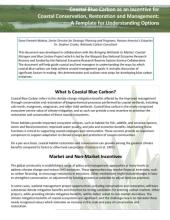
In the struggle to slow climate change, coastal wetlands are a critical asset—acre for acre, they can store up to five times as much carbon as rainforests. When wetlands are damaged or destroyed, they shift from being carbon “sinks ” to being carbon sources that release greenhouse gases into the atmosphere. Unfortunately, wetlands are disappearing at an alarming pace, and decisions to develop, protect, or restore them are often made in the context of limited public resources. Trading wetlands carbon offsets on carbon markets is an exciting new approach to creating financial incentives for restoration and conservation. To help “bring wetlands to market, ” the Waquoit Bay Reserve led a cutting-edge, collaborative research project in 2011 that examined the relationship between salt marshes, climate change, and nitrogen pollution and developed tools to leverage the “blue carbon ” stored in wetlands to achieve broader management goals.
As part of this project, the team developed this guidance document to help coastal and land managers understand the ways by which coastal blue carbon can help them achieve their coastal management goals. It includes a discussion of significant factors in making this determination and outlines next steps for developing blue carbon initiatives.